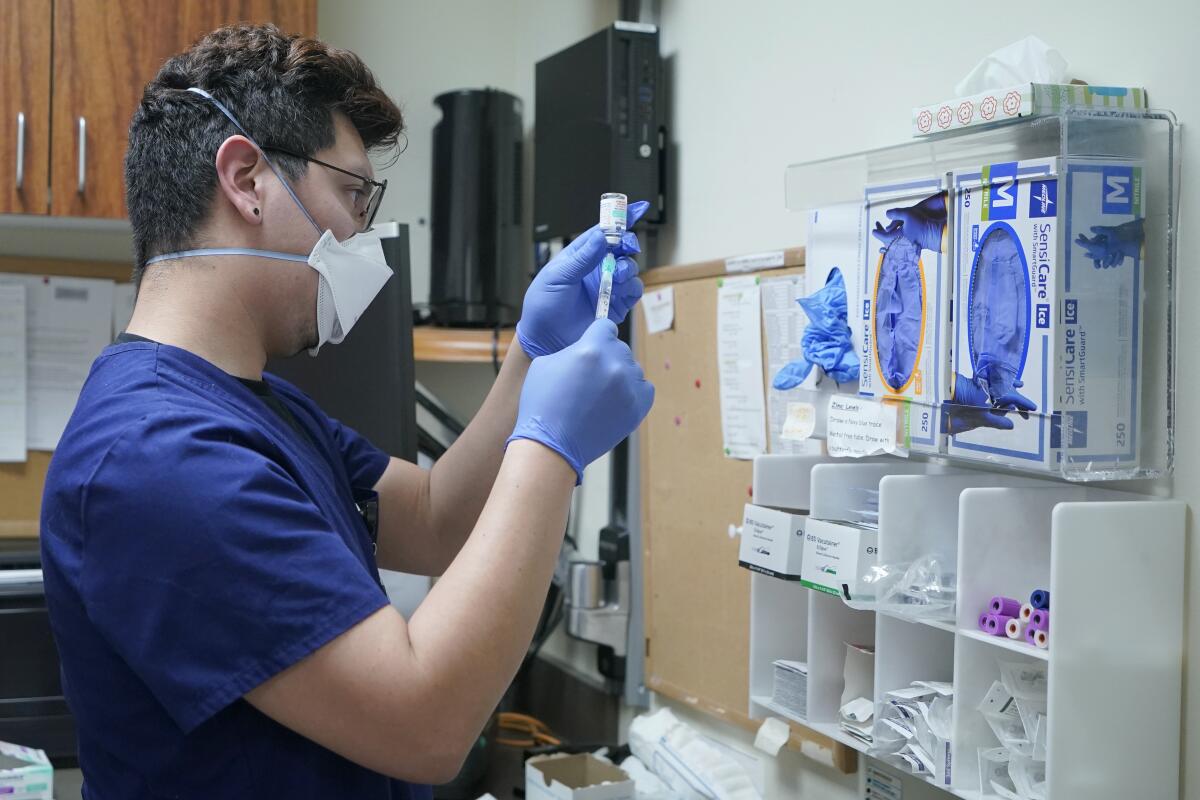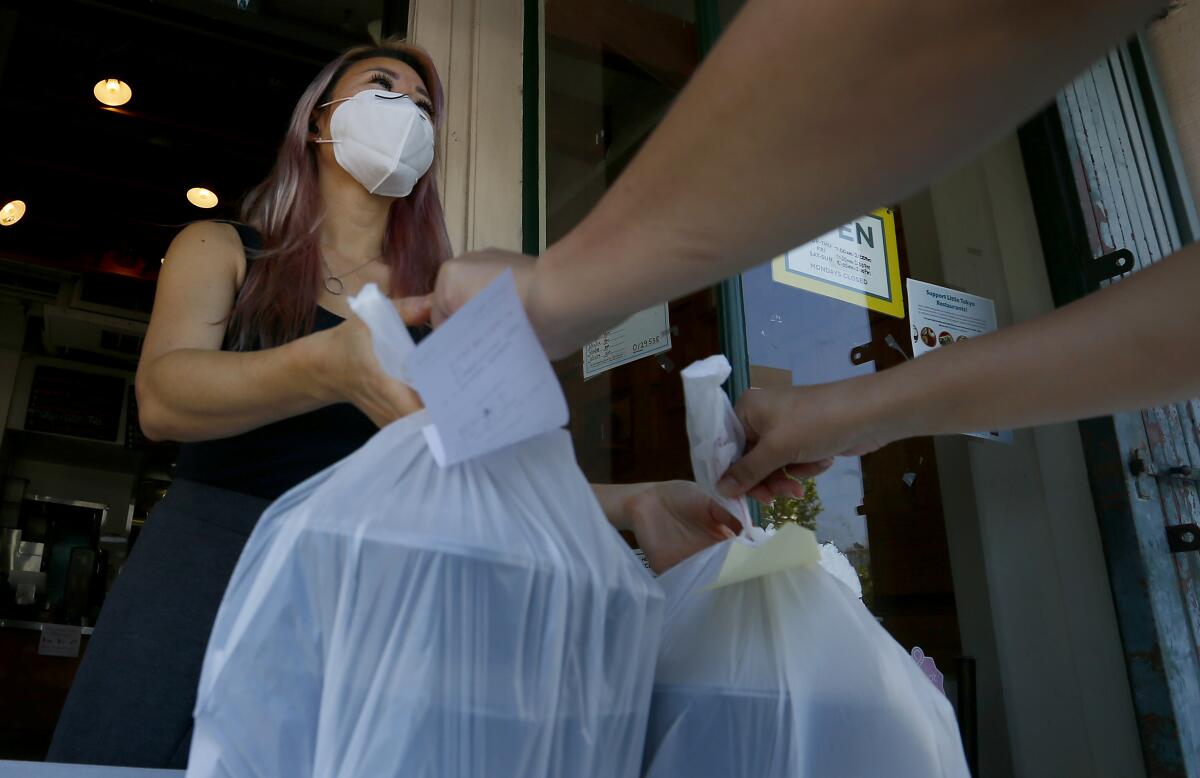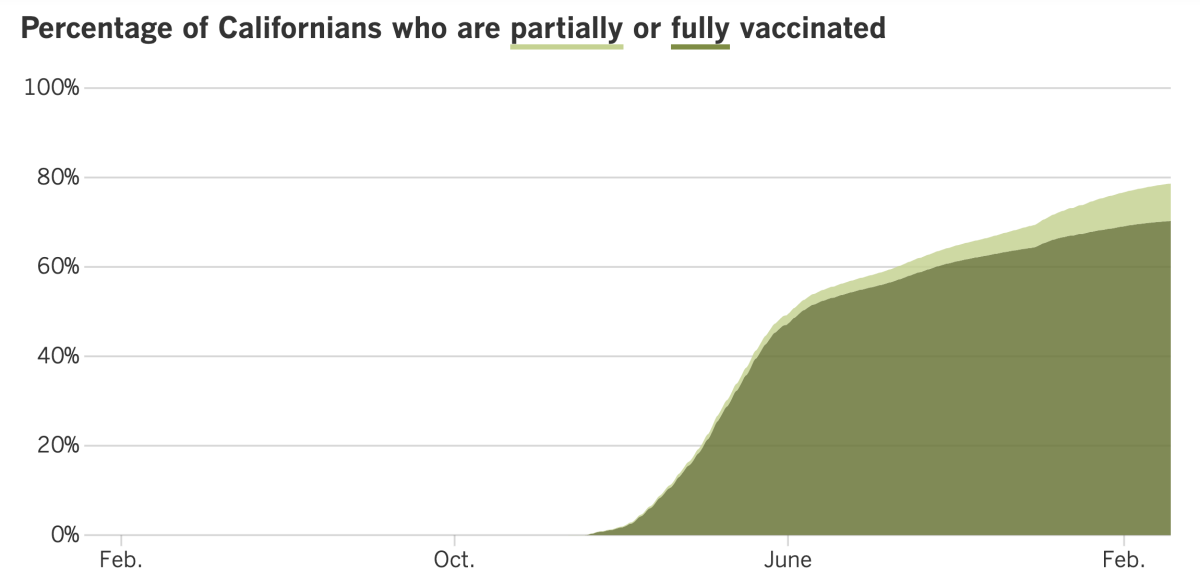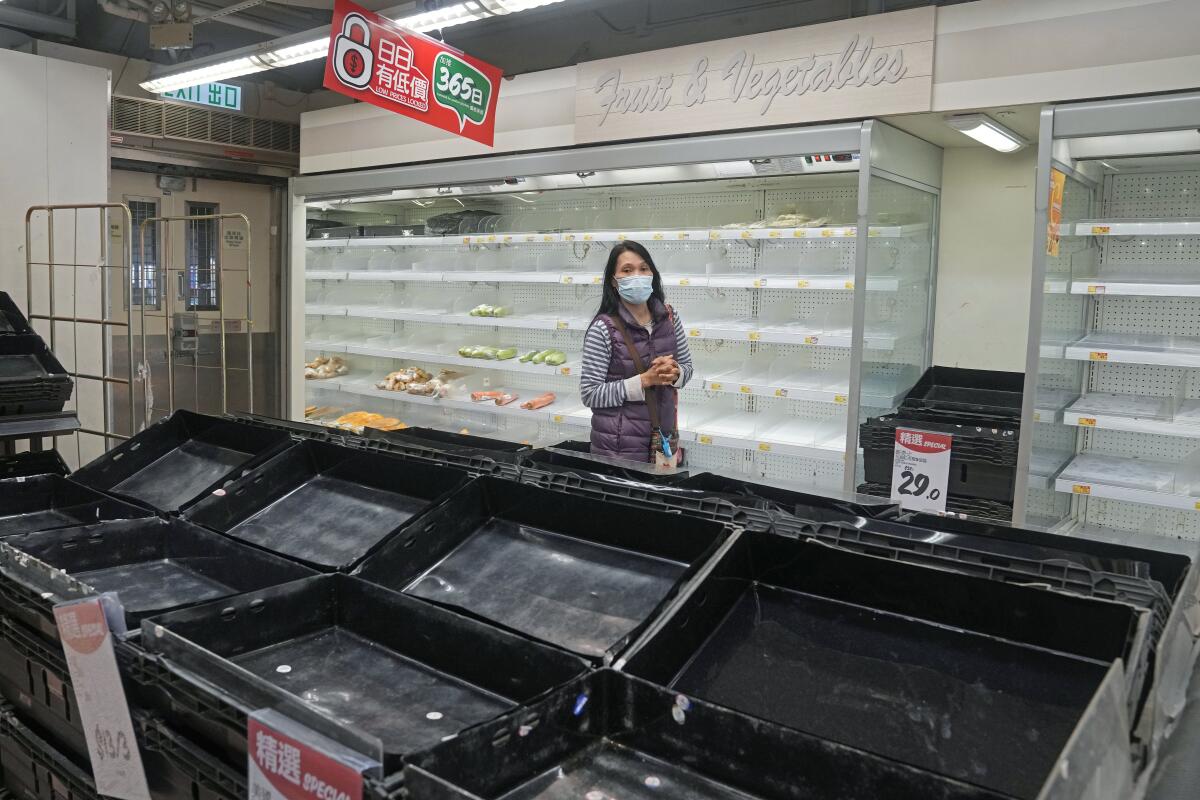Coronavirus Today: Nice drug if you can get it
- Share via
Good evening. I’m Karen Kaplan, and it’s Tuesday, March 8. Here’s the latest on what’s happening with the coronavirus in California and beyond.
People around the country are celebrating their newfound freedom to enter public spaces without wearing a mask, but Michele Nadeem-Baker is not one of them.
She doesn’t mean to be a killjoy — in fact, she’d love to ease up on COVID-19 precautions herself. But she has a type of blood cancer called chronic lymphocytic leukemia. People with CLL can live for many years, but their immune systems don’t function normally, and that means COVID-19 vaccines can’t give her the protection she needs.
Luckily for Nadeem-Baker and people like her, AstraZeneca has developed an injectable drug called Evusheld that would give her the coronavirus antibodies she’s missing. In a clinical trial, people who got a single dose of the treatment were 77% less likely to come down with COVID-19 than people who got a placebo. The longer the study participants were tracked, the greater the reduction in risk.
That’s the good news. The bad news is that only 600,000 doses of the drug have been delivered to U.S. states and territories to serve more than 7 million immunocompromised Americans. And as if those numbers weren’t out of whack already, the Food and Drug Administration last month adjusted its emergency-use authorization for Evusheld to recommend two doses instead of one.
In other words, an already scarce drug became twice as hard to get. And therein lies Nadeem-Baker’s problem.
“It’s insane that there’s such a small amount for so many people,” Nadeem-Baker told my colleague Emily Alpert Reyes.
“If you’re going to drop the mask mandate, please have enough Evusheld to go around for all the immunocompromised,” the Boston-area woman said. If not, “I will continue to be locked up and missing life.”
Cancer patients aren’t the only ones in this predicament. The population of immunocompromised people also includes organ transplant recipients who must take drugs to suppress their immune systems so that their new organs won’t be rejected. A study published in November in the journal Transplantation found that, compared to the general population of fully vaccinated adults, fully vaccinated transplant recipients were 82 times more likely to develop a breakthrough infection and 485 times more likely to be hospitalized or die as a result.
That’s why Tania Daniels was eager to get the treatment. A recipient of a heart transplant, she had no antibodies or T cells. So she started asking her doctors and nurses at Cedars-Sinai in Los Angeles about getting Evusheld. A nurse told her in January that “it did not look good at that time.”
She kept asking, however, and in February there were doses available. Getting the long-awaited antibodies gave her “tremendous relief,” Daniels said.

Immunocompromised patients and their supporters cite yet another problem with getting the drug: a lack of awareness that Evusheld even exists. Lots of patients don’t know to ask for it. And when they do, lots of doctors don’t know what it is.
Karol Franks can attest to that. She’d been keeping close tabs on a federal database that tracked the whereabouts of Evusheld doses in hopes of finding some for her 36-year-old daughter, Jenna, a triple-vaxxed kidney transplant patient with no antibodies. When she noticed that the drug had been sent to hospitals near her home in Pasadena, she called them up right away.
“I said, ‘Hey, I see there’s Evusheld.’ And they’re like, ‘What’s Evusheld?’” Franks said.
Michael Stubbs, a retiree in Santa Barbara who has rheumatoid arthritis and other immune conditions, was one of the first people in his county to get the treatment. He’s grateful he did, but he worries about his fellow patients who don’t have the time or the means to track it down like he did.
“I’m white. I’m educated. I’m affluent. I have connections. My doctor has connections. ... That’s a privileged position to be in,” Stubbs said. “My God, what about the folks ... who don’t have the resources I do?”
Daniels, the heart transplant recipient, frets on behalf of the millions of immunocompromised patients who still need Evusheld but aren’t likely to get it soon.
“Each state handles it differently. Each county handles it differently. Each institution handles it differently. And then you add on the fact that there’s not enough supply?” she said. “It’s a mess.”
By the numbers
California cases and deaths as of 5:55 p.m. on Tuesday:

Track California’s coronavirus spread and vaccination efforts — including the latest numbers and how they break down — with our graphics.
What we’ve lost, what we’ve gained
It was the spring of 2020, during the initial pandemic lockdown, and filmmaker Marcus Mizelle was hungry. So he placed a to-go order at Belle Vie, a French Bistro on Wilshire Boulevard a few blocks west of the 405. Mizelle was a regular, and when he arrived to pick up his food, he was curious to hear how the place and its owner, third-generation restaurateur Vincent Samarco, were holding up.
By the time Mizelle walked out the door, he had a plan to turn his curiosity into a documentary.
“What popped in my head, from a storyteller standpoint, is No. 1, you have this wonderful protagonist — colorful, nice, wonderful — it was a no-brainer,” he told my colleague Stephanie Breijo. “But you also have this conflict — the pandemic — and you also have this adaptation he was about to go toward. That’s like one-half of the hero’s journey right there. It just instinctively made sense.”
Mizelle shot 125 to 150 hours of footage at the restaurant, at Samarco’s L.A. home and in France with Samarco’s family. The result is “Belle Vie,” a 77-minute feature that will premiere Wednesday at the Santa Barbara International Film Festival. A 58-minute version will air March 15 on KCET.
The film is “a portrait of an optimistic and determined restaurateur trying something — anything — to keep his small business afloat,” Breijo writes.
The restaurant was only 3½ years old when the pandemic arrived. Situated on a block with a Kentucky Fried Chicken on one end and a McDonald’s on the other, Belle Vie served up moules marinière, steak tartare and other French classics. Business was good in 2019, and 2020 might have been even better.

Samarco was hardly the only restaurant owner forced to adjust to the unprecedented circumstances. The National Restaurant Assn. estimates that 90,000 or so eateries had to close their doors for long periods of time, if not permanently.
There would be no survival without adaptation. In the pandemic’s early days, that meant figuring out how to stuff an entire branzino into a small aluminum takeout box. Later, it meant installing plexiglass between booths and building a patio for outdoor dining.
In a scene filmed in July 2020, amid the outbreak’s second surge, Samarco fills large wooden containers with fertilizer.
“[I’m] ready to do anything to try to save the business,” he explained. “Look at me, trying to plant some trees in an alley behind a McDonald’s.”
Despite all his best efforts, Samarco found himself closing the bistro for good in December 2020.
“A year ago we were killing it,” he says in the film as he removes artwork from the restaurant’s walls and packs up copper pans once owned by his grandfather.
He told Breijo he longs to open another French restaurant, but economic conditions aren’t favorable for a cuisine with lots of ingredients, many of them expensive. Instead, his next restaurant will serve food that travels well and requires less overhead — perhaps pizza. More important than the type of food he serves is the community he can create by owning a restaurant, he said.
“Belle Vie” is a reminder of some of the things we lost during the pandemic. But we gained some things, too.
Samarco and Mizelle have plans to go to France to shoot a TV pilot for a food-oriented travel show this spring. The two play poker, see movies together and talk several times a week.
“He’s one of my best friends now,” Mizelle said.
California’s vaccination progress


See the latest on California’s vaccination progress with our tracker.
Your support helps us deliver the news that matters most.
In other news ...
It’s time for another grim milestone: The official global death toll from COVID-19 passed the 6-million mark Monday, according to the running tally maintained by Johns Hopkins University.
Masks may be coming off, vaccine requirements may be falling by the wayside, quarantine rules may be ending and borders may be opening to international travel. But the highly contagious Omicron variant is still on the loose, and it’s killing thousands of people around the world each day — most of them unvaccinated, officials said.
Some places are grappling with high case numbers for the first time since the pandemic began more than two years ago. That includes remote Pacific islands that were long protected by their physical isolation. Tonga, for instance, recorded its first outbreak after infected international aid workers arrived in the wake of a violent volcanic eruption on Jan. 15.
Since early on in year two of the pandemic, the world had been logging deaths at a rate of about 1 million every three months. But in a positive sign, it took more than four months to go from 5 million to 6 million.
The true death toll is certainly higher, since a lack of tests and other problems caused many cases to go uncounted. A recent analysis of excess deaths during the pandemic determined that the actual number of global COVID-19 deaths is somewhere between 14.1 million and 23.8 million.
In recognition that the pandemic still has legs, a group of experts convened by the World Health Organization said Tuesday that it “strongly supports urgent and broad access” to COVID-19 booster shots.
The statement was particularly notable in light of the WHO’s repeated insistence last year that booster shots weren’t needed for healthy people, and that wealthy countries that administered them to their already vaccinated residents were exacerbating the problem of vaccine inequity.
The new position acknowledged that boosters are effective at preventing severe and fatal cases of COVID-19 as immunity wanes and Omicron spreads. The global health agency said boosters, along with primary doses, are especially important for those at risk of becoming seriously ill.
The surgeon general of Florida thinks he knows something about COVID-19 vaccines that the WHO and the U.S. Centers for Disease Control and Prevention do not.
“The Florida Department of Health is going to be the first state to officially recommend against the COVID-19 vaccines for healthy children,” Dr. Joseph Ladapo said Monday at an event organized by Gov. Ron DeSantis (the man who last week bullied high school students for opting to wear face masks at an indoor public event).
Ladapo didn’t say when this new guidance from the state would be coming or offer any other details to square it with the scientific evidence that the vaccines are indeed effective in children as young as 5.
Experts who are familiar with the science were troubled by Ladapo’s remarks.
“I’m really concerned that this is going to make parents question what they are hearing from every other source: pediatricians, the American Academy of Pediatrics, the CDC,” said Dr. Sonja Rasmussen, a pediatrician at the University of Florida and a former infectious-disease specialist at the CDC. Nearly 1,000 U.S. children have died of COVID-19, and not all of them had an underlying illness like asthma or diabetes, Rasmussen noted.
Less than two weeks ago, Ladapo and DeSantis unveiled new guidance that discouraged the use of masks in workplaces and urged physicians to exercise their own judgment when treating COVID-19 patients, including the use of medications approved for other purposes. DeSantis’ profile in the Republican Party has risen as a result of his resistance to public health advice from the CDC and other federal experts.
Speaking of politics, the truck drivers in the so-called People’s Convoy made it to the Washington, D.C., area this weekend and drove two laps around the Beltway that encircles the city. The tractor-trailers, RVs, pickup trucks and other vehicles moved slowly enough to cause some congestion, though other cars were able to get around them.
Members of the convoy departed Adelanto in California’s Mojave Desert on Feb. 23 with a goal of protesting the federal government’s COVID-19 mandates. As they cruised the Beltway, supporters crowded onto overpasses with signs and flags. The convoy returned to the Beltway on Monday.
In Los Angeles County, coronavirus transmission continues to decline, and the test positivity rate is just 1%, according to the health department. The seven-day average of new cases has dropped more than 60% in the last two weeks, while the number of patients hospitalized with coronavirus infections fell 47% during the same period.
USC acknowledged that progress by lifting its indoor mask rules for most campus facilities, effective Monday. Masks are still required on university shuttles and in healthcare facilities, per federal and state rules. But viral transmission is now low enough that people can make up their own minds about wearing masks in other settings, school officials said.
The trends should bode well for a proposal to ease Los Angeles city rules that require restaurants, bars, movie theaters, gyms, hair salons and other business to check for proof of COVID-19 vaccination before allowing patrons to enter.
The proposal from L.A. City Council President Nury Martinez would make vaccination checks voluntary instead of mandatory and would drop requirements for major outdoor events in L.A. to check if patrons are vaccinated. It’s unclear when the rules, known as SafePassLA, would be rolled back or eliminated, but doing either would require approval from the City Council.
L.A. County Public Health Director Barbara Ferrer said the proposal was reasonable considering the progress that’s been made in reducing community COVID-19 levels. “We’re in a different place today than we’ve been before,” she said.
Nevertheless, some hot spots remain. An active outbreak at the state prison in Lancaster infected 1,869 inmates and 864 staff as of Saturday, with 14 deaths. An outbreak at Men’s Central Jail in Los Angeles spread to 1,305 inmates and 499 staff, with 12 deaths. Twelve more died at the Twin Towers Correctional Facility as part of an outbreak that spread to 4,285 inmates and 1,136 staff.
Your questions answered
Today’s question comes from readers who want to know: If I got the Johnson & Johnson vaccine, should I get two booster shots instead of just one?
The CDC’s official answer is that one booster is fine. The agency says you should get it as soon as two months after your initial jab, and that you should choose one of the mRNA vaccines (unless you have a specific reason to avoid them, such as an allergy to one of the ingredients).
I’ve heard from many readers who are skeptical that this is enough. If you got one initial dose of J&J, plus a Moderna booster (which contains half the dose of the primary Moderna shot), you might be thinking you’ve had only 1½ doses, while people who got the Pfizer-BioNTech vaccine for their initial series and their booster have had three.
Rest assured, the math doesn’t work that way.
“It’s not like one J&J plus one Moderna equals 1.5 Pfizer doses,” Dr. George Rutherford, a professor of epidemiology at UCSF, told Bernard J. Wolfson of KHN.
Wolfson reached out for advice because he is among the 7.8% of Americans who got the J&J vaccine, and he followed it up with a Moderna booster. When he tried to book a second booster appointment, he was turned down by a pharmacy on the grounds that he wasn’t eligible.
A second pharmacy did give him appointment, but he wound up canceling. He opted to sit tight on the advice of experts like Rutherford, and because of a spate of reassuring studies showing that boosters prompt the immune system to make a wide variety of antibodies, as well as long-lasting T cells. (The latter are useful because they kill infected cells and prompt the immune system to make more antibodies.)
If you’re immunocompromised, the math is a little different. The CDC recommends that these adults get a second primary dose (preferably of an mRNA vaccine) at least 28 days after their J&J shot, then get a booster (again, an mRNA vaccine is preferred) at least two months after that.
We want to hear from you. Email us your coronavirus questions, and we’ll do our best to answer them. Wondering if your question’s already been answered? Check out our archive here.
The pandemic in pictures

Is it Throwback Tuesday? Is that why we’re featuring a picture of a grocery store with almost nothing left to sell?
Actually, that photo was taken just four days ago in Hong Kong.
The Omicron variant is overwhelming the city, causing about 150 COVID-19 deaths per day. That’s more than 29 deaths per million residents over the past week — the highest mortality rate in the world right now, according to Our World in Data. To put that in perspective, in the U.S., we’re recording about 4 deaths per million people.
There are lots of photos of Hong Kong residents snaking through lines to get mandatory coronavirus tests and of patients in beds outside overcrowded hospitals. But we’ve become inured to those.
Seeing store shelves emptied by panicked shoppers is a striking reminder that the pandemic is still going strong, even in a place as wealthy as Hong Kong. The city of nearly 7.5 million people had a total of 213 COVID-19 deaths in 2020 and 2021. So far in 2022, more than 2,000 residents have died.
Resources
Need a vaccine? Here’s where to go: City of Los Angeles | Los Angeles County | Kern County | Orange County | Riverside County | San Bernardino County | San Diego County | San Luis Obispo County | Santa Barbara County | Ventura County
Practice social distancing using these tips, and wear a mask or two.
Watch for symptoms such as fever, cough, shortness of breath, chills, shaking with chills, muscle pain, headache, sore throat and loss of taste or smell. Here’s what to look for and when.
Need to get a test? Testing in California is free, and you can find a site online or call (833) 422-4255.
Americans are hurting in various ways. We have advice for helping kids cope, as well as resources for people experiencing domestic abuse.
We’ve answered hundreds of readers’ questions. Explore them in our archive here.
For our most up-to-date coverage, visit our homepage and our Health section, get our breaking news alerts, and follow us on Twitter and Instagram.




